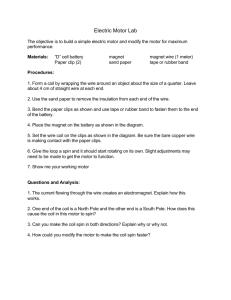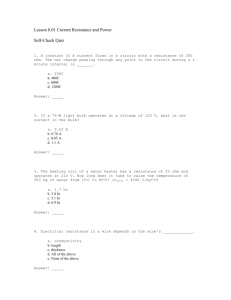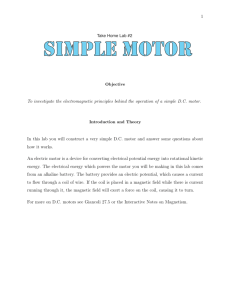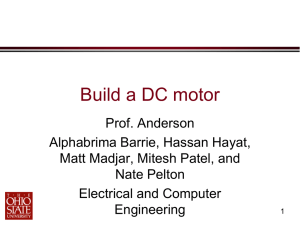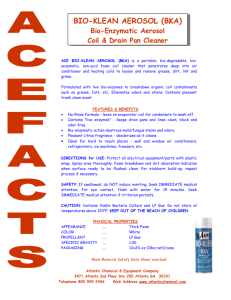Beakman's Electric Motor - Oklahoma State University
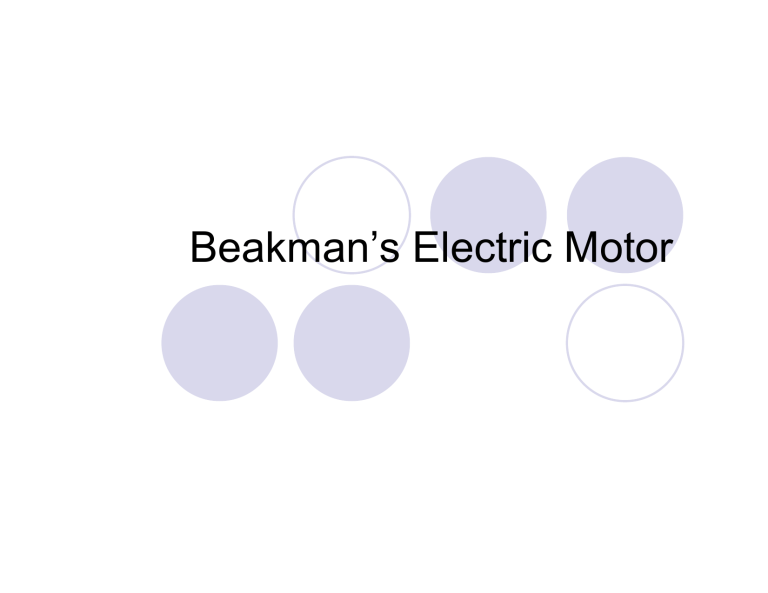
Beakman’s Electric Motor
Websites Used
z University of Florida Physics 3054
{ http://www.phys.ufl.edu/~phy3054/ z Beakman’s Electric Motor
{ http://fly.hiwaay.net/~palmer/motor.html
2
Magnetic Field
3
Current/Field Interaction
What happens when a current is driven through the wire?
4
Right-Hand Rule
5
Current Loop
6
DC Motor
7
Beakman’s Motor
8
Materials
z One 'D' Cell Alkaline Battery z One Wide Rubber Band z Two Large Paper Clips z One Rectangular Ceramic Magnet z Heavy Gauge Magnet Wire (the kind with red enamel insulation, not plastic coated) z One Toilet Paper Tube z Fine Sandpaper z Optional: Glue, Small Block of Wood for Base
9
Making the Coil
Starting about 3 inches from the end of the wire, wrap it 7 times around the toilet paper tube. Remove the tube (you don't need it any more). Cut the wire, leaving a 3 inch tail opposite the original starting point. Wrap the two tails around the coil so that the coil is held together and the two tails extend perpendicular to the coil.
10
Note: Be sure to center the two tails on either side of the coil. Balance is important.
You might need to put a drop of glue where the tail meets the coil to prevent slipping.
Sanding the Tails
On one tail, use fine sandpaper to completely remove the insulation from the wire. Leave about 1/4" of insulation on the end and where the wire meets the coil. On the other tail, lay the coil down flat and lightly sand off the insulation from the top half of the wire only. Again, leave 1/4" of full insulation on the end and where the wire meets the coil.
11
Paper Clips
Bend the two paper clips into the following shape:
Use the rubber band to hold the loop ends (on the left in the drawing to the left) to the terminals of the "D" Cell battery:
12
Battery and Coil Placement
Stick the magnet on the side of the battery as shown:
Place the coil in the cradle formed by the right ends of the paper clips. You may have to give it a gentle push to get it started, but it should begin to spin rapidly. If it doesn't spin, check to make sure that all of the insulation has been removed from the wire ends. If it spins erratically, make sure that the tails on the coil are centered on the sides of the coil. It might also help to bend the ends of the coil a bit so that as it slips right or left, the bends keep it in the proper position:
13
Final Motor
14
How it Works?
When the un-insulated parts of the coil make contact with the paper clips, current flows through the coil, making it into an electromagnet. Since magnets attract, the coil attempts to align itself with the ceramic magnet.
However, when the coil turns to face the magnet, contact is broken (because the insulation on one tail is now preventing current flow). Inertia causes the coil to continue around. When the coil makes are nearly complete spin, contact is re-established and the process repeats.
15
Further Experiments
z Can you find the north pole of the magnet?
z How does the orientation of the magnet affect the operation of the motor?
z Can you change the direction of rotation of the motor?
z Is the circle the best shape? Try squares, ovals, etc.
z Try varying the number of turns in the coil.
Does this affect speed?
z How long can you get the motor to run before it falls off the cradle?
16
